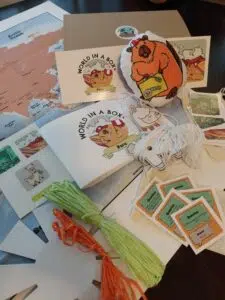We mostly do UNIT STUDIES for our science and social studies and they are often interconnected.
✅ UNIT STUDIES help to teach a big picture that makes learning more meaningful and also works on critical thinking skills.
✅ UNIT STUDIES are engaging for my daughter as she has her say so she is motivated and retains a lot.
✅ UNIT STUDIES turned out to be time-savers for me as we can incorporate math and ELA practice without resistance from my daughter. Totally worth the preparation time!
✅ And UNIT STUDIES are fun!
————————————————————————-
I try to keep our units seasonal and connect them together to make our learning as meaningful as possible. In each unit we incorporate non-fiction reading, writing a summary, some geography and history. And also whatever else I can throw in.
We usually have 4 science and social studies lessons per week combined.
You DO NOT HAVE TO or it would be even beneficial for most kids to cover everything I write here in one year. You also don’t have to start on the 1st of each month or on the same day each month – use your best judgement and enjoy homeschooling flexibility!
If your children are young or not much interested in science, do basics and repeat the same cycle on the deeper level next year.
If your children are more advanced scientists and already familiar with some topics you can just briefly review basics (to make sure they actually retain it!) and dive deeper.
Now we are in our 2nd year of unit studies. Not everything went smoothly in the first year. We were completely derailed last spring when a pandemic hit so we are now catching up and working on our Space unit. But if I had done the unit studies for early years again and without pandemic I would do it in this order.
————————————————————————-
January – GLOBE, continents and maps. We can talk about winter in the Northern hemisphere and move to ->
February – ANIMALS IN WINTER – hibernation (and Groundhog Day!), adaptations and migration (hey, maps!). In the end of winter we can observe animals waking up and birds coming back as there is some food for them now and move to the next unit ->
March – PLANTS – types, life cycle, parts and photosynthesis. As everything starts to bloom mid April we can learn more about ->
April – FLOWERS – types, parts and pollination which brings us to the next unit ->
May – INSECTS – general characteristics and classification. You can even start rising caterpillars and move to ->
June – MOTHS and BUTTERFLIES and the difference between them. As we spend more time outdoors in summer it’s also a great time to learn more about any particular insect your child observes or is interested in ->
July – WATER CYCLE – the cycle itself and how the water comes in our homes. [More advanced learners can learn more about water and its properties as well as states of matter.] Learning about precipitation eventually brings us to the next unit ->
August – WEATHER – clouds, wind and forecasting, [More advanced learners can learn about air and flight also as well.] As the weather gets cooler and days are shorter we move to ->
September – SEASONS – what seasons are, why do they change, what is time, how calendar and clock were invented and how we use them now. [Also a great time to review plants life cycle and seeds dispersal.] After learning about the Sun and the Earth we can also learn about ->
October – MOON and its phases. And as it’s getting dark early it’s easy to observe and learn about ->
November – CONSTELLATIONS. Along with stars we also can observe some planets in the night sky and get ready to learn about ->
December – SOLAR SYSTEM. And wrap up this big Space unit learning about winter solstice. And there are some possible options to continue and I have not decided yet which way we will go. ->
If your child is more interested in nature studies – refresh memory about the clock and the calendar, Time Zones and then move to GLOBE to start learning about different landforms, water bodies or habitats. ->
If your child is more interested in physics you can learn about Light and Shadow in connection with the Winter Solstice and first calendars. From there you can move to the Sound unit or Senses (and there are more than 5!) as the first part of the bigger Human Body unit.
Stay tuned for other ideas!
#homeschool #homeschooling #unitstudies #kindergarten #preschool #elementary #stem #science #naturalscience #socialstudies













